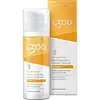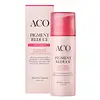What's inside
What's inside
 Key Ingredients
Key Ingredients

 Benefits
Benefits

 Concerns
Concerns

 Ingredients Side-by-side
Ingredients Side-by-side

Water
Skin ConditioningPropanediol
SolventCaprylic/Capric Triglyceride
MaskingCetearyl Alcohol
EmollientTapioca Starch
Canola Oil
EmollientCoco-Caprylate/Caprate
EmollientGlycerin
HumectantC15-19 Alkane
SolventSqualane
EmollientArachidyl Alcohol
EmollientJojoba Esters
EmollientAscorbyl Glucoside
AntioxidantCaprylic/Capric/Succinic Triglyceride
EmollientHydrogenated Coco-Glycerides
EmollientOctyldodecyl Myristate
EmollientCeramide NP
Skin ConditioningCeramide Ns
Skin ConditioningCeramide AP
Skin ConditioningCeramide EOP
Skin ConditioningCeramide Eos
Skin ConditioningHippophae Rhamnoides Fruit Juice
Skin ConditioningCitrus Grandis Fruit Extract
AstringentTetrapeptide-30
Skin ConditioningTocopherol
AntioxidantTocopheryl Acetate
AntioxidantCaprylyl Methicone
Skin ConditioningDimethicone
EmollientBehenyl Alcohol
EmollientHelianthus Annuus Seed Wax
Skin ConditioningStearic Acid
CleansingArachidyl Glucoside
EmulsifyingPalmitic Acid
EmollientCetearyl Glucoside
EmulsifyingSodium Citrate
BufferingXanthan Gum
EmulsifyingSodium Hydroxide
BufferingTetrasodium Iminodisuccinate
Caprylyl Glycol
EmollientAcacia Decurrens Flower Wax
EmollientCeteareth-25
CleansingPolyglycerin-3
HumectantCitric Acid
BufferingCetyl Alcohol
EmollientBehenic Acid
CleansingCholesterol
EmollientCaprooyl Phytosphingosine
Skin ConditioningCaprooyl Sphingosine
Skin ConditioningAscorbyl Palmitate
AntioxidantEthylhexylglycerin
Skin ConditioningPhenoxyethanol
PreservativeSodium Benzoate
MaskingPotassium Sorbate
PreservativeWater, Propanediol, Caprylic/Capric Triglyceride, Cetearyl Alcohol, Tapioca Starch, Canola Oil, Coco-Caprylate/Caprate, Glycerin, C15-19 Alkane, Squalane, Arachidyl Alcohol, Jojoba Esters, Ascorbyl Glucoside, Caprylic/Capric/Succinic Triglyceride, Hydrogenated Coco-Glycerides, Octyldodecyl Myristate, Ceramide NP, Ceramide Ns, Ceramide AP, Ceramide EOP, Ceramide Eos, Hippophae Rhamnoides Fruit Juice, Citrus Grandis Fruit Extract, Tetrapeptide-30, Tocopherol, Tocopheryl Acetate, Caprylyl Methicone, Dimethicone, Behenyl Alcohol, Helianthus Annuus Seed Wax, Stearic Acid, Arachidyl Glucoside, Palmitic Acid, Cetearyl Glucoside, Sodium Citrate, Xanthan Gum, Sodium Hydroxide, Tetrasodium Iminodisuccinate, Caprylyl Glycol, Acacia Decurrens Flower Wax, Ceteareth-25, Polyglycerin-3, Citric Acid, Cetyl Alcohol, Behenic Acid, Cholesterol, Caprooyl Phytosphingosine, Caprooyl Sphingosine, Ascorbyl Palmitate, Ethylhexylglycerin, Phenoxyethanol, Sodium Benzoate, Potassium Sorbate
Water
Skin ConditioningNiacinamide
SmoothingDiethylhexyl Carbonate
EmollientGlycerin
HumectantCanola Oil
EmollientPropanediol
SolventDimethicone
EmollientCetearyl Olivate
1,2-Hexanediol
Skin ConditioningSorbitan Olivate
EmulsifyingCetyl Dimethicone
EmollientHydrolyzed Hyaluronic Acid
HumectantAscorbyl Tetraisopalmitate
AntioxidantTocopheryl Acetate
AntioxidantSaccharide Isomerate
HumectantPapain
Skin ConditioningSucrose Stearate
EmollientGlyceryl Stearate
EmollientCetearyl Alcohol
EmollientHydroxyacetophenone
AntioxidantAmmonium Acryloyldimethyltaurate/Vp Copolymer
Acrylates/C10-30 Alkyl Acrylate Crosspolymer
Emulsion StabilisingXanthan Gum
EmulsifyingN-Hydroxysuccinimide
Skin ConditioningCaprylyl Glycol
EmollientCarbomer
Emulsion StabilisingAlgin
MaskingPhenoxyethanol
PreservativeParfum
MaskingWater, Niacinamide, Diethylhexyl Carbonate, Glycerin, Canola Oil, Propanediol, Dimethicone, Cetearyl Olivate, 1,2-Hexanediol, Sorbitan Olivate, Cetyl Dimethicone, Hydrolyzed Hyaluronic Acid, Ascorbyl Tetraisopalmitate, Tocopheryl Acetate, Saccharide Isomerate, Papain, Sucrose Stearate, Glyceryl Stearate, Cetearyl Alcohol, Hydroxyacetophenone, Ammonium Acryloyldimethyltaurate/Vp Copolymer, Acrylates/C10-30 Alkyl Acrylate Crosspolymer, Xanthan Gum, N-Hydroxysuccinimide, Caprylyl Glycol, Carbomer, Algin, Phenoxyethanol, Parfum
Ingredients Explained
These ingredients are found in both products.
Ingredients higher up in an ingredient list are typically present in a larger amount.
Canola Oil is Rapeseed oil with low amounts of erucic acid. It is an emollient and helps hydrate the skin. Emollients help hydrate and soften your skin by trapping moisture.
The comedogenic rating of canola oil is 4.
Canola oil contains Vitamin E, Vitamin K, and fatty acids such as linoleic acid.
Learn more about Canola OilCaprylyl Glycol is a humectant and emollient, meaning it attracts and preserves moisture.
It is a common ingredient in many products, especially those designed to hydrate skin. The primary benefits are retaining moisture, skin softening, and promoting a healthy skin barrier.
Though Caprylyl Glycol is an alcohol derived from fatty acids, it is not the kind that can dry out skin.
This ingredient is also used as a preservative to extend the life of products. It has slight antimicrobial properties.
Learn more about Caprylyl GlycolCetearyl alcohol is a mixture of two fatty alcohols: cetyl alcohol and stearyl alcohol. It is mainly used as an emulsifier. Emulsifiers help prevent the separation of oils and products. Due to its composition, it can also be used to thicken a product or help create foam.
Cetearyl alcohol is an emollient. Emollients help soothe and hydrate the skin by trapping moisture.
Studies show Cetearyl alcohol is non-toxic and non-irritating. The FDA allows products labeled "alcohol-free" to have fatty alcohols.
This ingredient is usually derived from plant oils such as palm, vegetable, or coconut oils. There is debate on whether this ingredient will cause acne.
Due to the fatty acid base, this ingredient may not be Malassezia folliculitis safe.
Learn more about Cetearyl AlcoholDimethicone is a type of synthetic silicone created from natural materials such as quartz.
What it does:
Dimethicone comes in different viscosities:
Depending on the viscosity, dimethicone has different properties.
Ingredients lists don't always show which type is used, so we recommend reaching out to the brand if you have questions about the viscosity.
This ingredient is unlikely to cause irritation because it does not get absorbed into skin. However, people with silicone allergies should be careful about using this ingredient.
Note: Dimethicone may contribute to pilling. This is because it is not oil or water soluble, so pilling may occur when layered with products. When mixed with heavy oils in a formula, the outcome is also quite greasy.
Learn more about DimethiconeGlycerin is already naturally found in your skin. It helps moisturize and protect your skin.
A study from 2016 found glycerin to be more effective as a humectant than AHAs and hyaluronic acid.
As a humectant, it helps the skin stay hydrated by pulling moisture to your skin. The low molecular weight of glycerin allows it to pull moisture into the deeper layers of your skin.
Hydrated skin improves your skin barrier; Your skin barrier helps protect against irritants and bacteria.
Glycerin has also been found to have antimicrobial and antiviral properties. Due to these properties, glycerin is often used in wound and burn treatments.
In cosmetics, glycerin is usually derived from plants such as soybean or palm. However, it can also be sourced from animals, such as tallow or animal fat.
This ingredient is organic, colorless, odorless, and non-toxic.
Glycerin is the name for this ingredient in American English. British English uses Glycerol/Glycerine.
Learn more about GlycerinPhenoxyethanol is a preservative that has germicide, antimicrobial, and aromatic properties. Studies show that phenoxyethanol can prevent microbial growth. By itself, it has a scent that is similar to that of a rose.
It's often used in formulations along with Caprylyl Glycol to preserve the shelf life of products.
Propanediol is an all-star ingredient. It softens, hydrates, and smooths the skin.
It’s often used to:
Propanediol is not likely to cause sensitivity and considered safe to use. It is derived from corn or petroleum with a clear color and no scent.
Learn more about PropanediolTocopheryl Acetate is AKA Vitamin E. It is an antioxidant and protects your skin from free radicals. Free radicals damage the skin by breaking down collagen.
One study found using Tocopheryl Acetate with Vitamin C decreased the number of sunburned cells.
Tocopheryl Acetate is commonly found in both skincare and dietary supplements.
Learn more about Tocopheryl AcetateWater. It's the most common cosmetic ingredient of all. You'll usually see it at the top of ingredient lists, meaning that it makes up the largest part of the product.
So why is it so popular? Water most often acts as a solvent - this means that it helps dissolve other ingredients into the formulation.
You'll also recognize water as that liquid we all need to stay alive. If you see this, drink a glass of water. Stay hydrated!
Learn more about WaterXanthan gum is used as a stabilizer and thickener within cosmetic products. It helps give products a sticky, thick feeling - preventing them from being too runny.
On the technical side of things, xanthan gum is a polysaccharide - a combination consisting of multiple sugar molecules bonded together.
Xanthan gum is a pretty common and great ingredient. It is a natural, non-toxic, non-irritating ingredient that is also commonly used in food products.
Learn more about Xanthan Gum